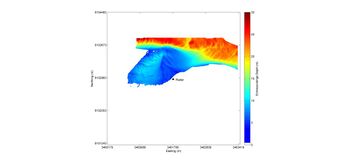Difference between revisions of "Template:This weeks featured article"
(→Bathymetry from inverse wave refraction) |
(→Bathymetry from inverse wave refraction) |
||
| Line 5: | Line 5: | ||
It is possible to determine the [[bathymetry]] of a certain area using radar data. On the Island of Sylt at the German Bight Coast, measurements are done during storm conditions. This data is processed based on inversion of the non-linear and linear wave theory. More about the area of investigation, data processing, result and discussion of the results can be found in the article. | It is possible to determine the [[bathymetry]] of a certain area using radar data. On the Island of Sylt at the German Bight Coast, measurements are done during storm conditions. This data is processed based on inversion of the non-linear and linear wave theory. More about the area of investigation, data processing, result and discussion of the results can be found in the article. | ||
| − | The determination of the [[bathymetry]] in coastal environments by utilizing the ocean wave-shoaling photographic imagery, and the observed reduction of ocean wave phase speed with decreased water depth, is used since the WW-II (Williams 1946)<ref>Williams, W.W. 1946, The determination of gradients of enemy-held beaches. Geographical Journal 107, 76–93.</ref>. The last decade, with the expansion of different ground based instrumentations, mainly radar and video imagery, for the observation of the sea surface and the exponential increase of the computational power, several methodologies for the [[bathymetry]] reckoning have been published | + | The determination of the [[bathymetry]] in coastal environments by utilizing the ocean wave-shoaling photographic imagery, and the observed reduction of ocean wave phase speed with decreased water depth, is used since the WW-II (Williams 1946)<ref>Williams, W.W. 1946, The determination of gradients of enemy-held beaches. Geographical Journal 107, 76–93.</ref>. The last decade, with the expansion of different ground based instrumentations, mainly radar and video imagery, for the observation of the sea surface and the exponential increase of the computational power, several methodologies for the [[bathymetry]] reckoning have been published. The core of the previously mentioned methods is the inversion of the wave characteristics by assuming the validity of linear or non-linear models for the propagation of the wavefield over uneven sea bottom. |
In the present investigation, twelve hourly radar datasets acquired during storm conditions are analyzed by two methods: The non-linear method of Bell et al. 2004<ref name="bell"/> (henceforth BW04), which is based on the inversion of the non-linear [[Dispersion (waves)|wave dispersion]] equation of Hedges (1976)<ref>Hedges, T.S. 1976, An empirical modification to linear wave theory, Proc. Inst. Civ. Eng., 61, pp. 575-579.</ref> and the Dispersive Surface Classificator (henceforth DiSC08), Senet et al. 2008<ref name="sen"/>, which is based on the inversion of the linear wave theory. The results are validated as bathymetric retrieving instruments and the two wave propagation theories are compared about their sensitivity to the local bathymetric relief. The two methods are compared under the assumption of fundamentally similar implemented algorithms. | In the present investigation, twelve hourly radar datasets acquired during storm conditions are analyzed by two methods: The non-linear method of Bell et al. 2004<ref name="bell"/> (henceforth BW04), which is based on the inversion of the non-linear [[Dispersion (waves)|wave dispersion]] equation of Hedges (1976)<ref>Hedges, T.S. 1976, An empirical modification to linear wave theory, Proc. Inst. Civ. Eng., 61, pp. 575-579.</ref> and the Dispersive Surface Classificator (henceforth DiSC08), Senet et al. 2008<ref name="sen"/>, which is based on the inversion of the linear wave theory. The results are validated as bathymetric retrieving instruments and the two wave propagation theories are compared about their sensitivity to the local bathymetric relief. The two methods are compared under the assumption of fundamentally similar implemented algorithms. | ||
Revision as of 15:20, 19 January 2009
Bathymetry from inverse wave refraction
It is possible to determine the bathymetry of a certain area using radar data. On the Island of Sylt at the German Bight Coast, measurements are done during storm conditions. This data is processed based on inversion of the non-linear and linear wave theory. More about the area of investigation, data processing, result and discussion of the results can be found in the article.
The determination of the bathymetry in coastal environments by utilizing the ocean wave-shoaling photographic imagery, and the observed reduction of ocean wave phase speed with decreased water depth, is used since the WW-II (Williams 1946)[1]. The last decade, with the expansion of different ground based instrumentations, mainly radar and video imagery, for the observation of the sea surface and the exponential increase of the computational power, several methodologies for the bathymetry reckoning have been published. The core of the previously mentioned methods is the inversion of the wave characteristics by assuming the validity of linear or non-linear models for the propagation of the wavefield over uneven sea bottom.
In the present investigation, twelve hourly radar datasets acquired during storm conditions are analyzed by two methods: The non-linear method of Bell et al. 2004[2] (henceforth BW04), which is based on the inversion of the non-linear wave dispersion equation of Hedges (1976)[3] and the Dispersive Surface Classificator (henceforth DiSC08), Senet et al. 2008[4], which is based on the inversion of the linear wave theory. The results are validated as bathymetric retrieving instruments and the two wave propagation theories are compared about their sensitivity to the local bathymetric relief. The two methods are compared under the assumption of fundamentally similar implemented algorithms.- ↑ Williams, W.W. 1946, The determination of gradients of enemy-held beaches. Geographical Journal 107, 76–93.
- ↑ Cite error: Invalid
<ref>tag; no text was provided for refs namedbell - ↑ Hedges, T.S. 1976, An empirical modification to linear wave theory, Proc. Inst. Civ. Eng., 61, pp. 575-579.
- ↑ Cite error: Invalid
<ref>tag; no text was provided for refs namedsen
